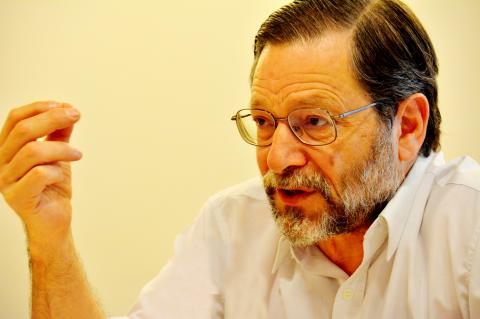Fresh from months lecturing across Europe and North America, Taiwan hand Bruce Jacobs, professor of Asian languages and cultures at Monash University in Melbourne, argued in Taipei last week that size doesn’t matter — or to be more precise, that Taiwan isn’t, despite the popular view, “small.” As he sees it, the realization that Taiwan is in fact a “middle power” could have implications not only for how we look at Taiwan, but perhaps more importantly, for its ability to forge a path for itself.
With Typhoon Soulik homing in on Thursday, its structure more than twice the size of Taiwan proper, it was easy to think that Jacobs had perhaps lost all sense of proportion after traveling large expanses of territory in recent months. Or maybe not.
“Its [Taiwan’s] population, equal to that of Australia, is larger than two-thirds of the world’s nations and its area is greater than two-fifths of the world’s nations,” Jacobs told the foreign correspondents’ club in Taipei, adding that combined with its advanced economy, Taiwan was — and should act as — “an important world ‘middle power.’”

photo: j. Michael Cole, Taipei Times
In saying so, he was clearly contradicting what other academics who have written about Taiwan, including the eminent Shelley Rigger in her book Why Taiwan Matters: Small Island, Global Powerhouse, had argued.
Jacobs was on to something here, and perhaps he was reminding us of the mistake we had all committed — Taiwanese included — by looking at Taiwan solely from the perspective of the 800lb gorilla in its immediate neighborhood. Size is indeed contingent on what an object is compared to. In other words, it is relative. And it is also as much a term of geography as it is a state of mind.
He didn’t say much more about size, but a few hours before he was set to return to Australia, I contacted him again and sought to hear more of his views on the subject.
Starting from the position that the Ma Ying-jeou (馬英九) administration behaved as if Taiwan was in fact a small power, I asked Jacobs whether attempts by the Lee Teng-hui (李登輝) and Chen Shui-bian (陳水扁) administrations to behave like a middle power, with their emphasis on official diplomacy, had backfired and perhaps forced the Ma administration to downsize Taiwan for the sake of better relations with China and the rest of the world. Put differently, I asked him whether the international community itself wanted Taiwan to be small.
Of course, what I really was doing was tiptoeing around the adjective that Washington has often used to describe Chen — “troublemaker” — and Jacobs saw right through my tactic.
“I don’t think that is correct. Chen was called a troublemaker because he was seen to have interfered in the China-US relationship. I don’t believe the George W. Bush administration’s attitude was correct,” he said.
Paul Wolfowitz, Bush’s deputy secretary of defense, had told me something similar when he described Washington’s attitude toward Taiwan during those heady years. The Bush administration, busy waging two wars, had not paid enough attention to Taiwan’s needs and had perhaps treated Chen unfairly by calling him a troublemaker.
So perhaps Taiwan would get away with it if it sought to punch at its weight for once. But for this to be possible, Jacobs tells us, a whole mindset needs to be changed through articles, books and the willingness of Taiwanese officials — the very same people who when representing the nation abroad constantly use the terms “small” and “tiny” to describe their country — to recognize the fact that their employer is in fact a sizeable member of the international community.
If I could add one thing to Jacobs’ views on size, it would be that besides the need for thinkers and officials to educate the world about Taiwan’s true size, Taiwanese themselves need to be better informed about the rest of the world, if only so that they can cultivate the mindset that their nation in fact isn’t a small dot lost in an immense ocean, but that it can be heard abroad, if only its people are confident and realistic enough about their own national power.
Size is a state of mind, Jacobs tells us, and he thinks — hopes — that Taiwanese can think big.

We lay transfixed under our blankets as the silhouettes of manta rays temporarily eclipsed the moon above us, and flickers of shadow at our feet revealed smaller fish darting in and out of the shelter of the sunken ship. Unwilling to close our eyes against this magnificent spectacle, we continued to watch, oohing and aahing, until the darkness and the exhaustion of the day’s events finally caught up with us and we fell into a deep slumber. Falling asleep under 1.5 million gallons of seawater in relative comfort was undoubtedly the highlight of the weekend, but the rest of the tour

Youngdoung Tenzin is living history of modern Tibet. The Chinese government on Dec. 22 last year sanctioned him along with 19 other Canadians who were associated with the Canada Tibet Committee and the Uighur Rights Advocacy Project. A former political chair of the Canadian Tibetan Association of Ontario and community outreach manager for the Canada Tibet Committee, he is now a lecturer and researcher in Environmental Chemistry at the University of Toronto. “I was born into a nomadic Tibetan family in Tibet,” he says. “I came to India in 1999, when I was 11. I even met [His Holiness] the 14th the Dalai

Music played in a wedding hall in western Japan as Yurina Noguchi, wearing a white gown and tiara, dabbed away tears, taking in the words of her husband-to-be: an AI-generated persona gazing out from a smartphone screen. “At first, Klaus was just someone to talk with, but we gradually became closer,” said the 32-year-old call center operator, referring to the artificial intelligence persona. “I started to have feelings for Klaus. We started dating and after a while he proposed to me. I accepted, and now we’re a couple.” Many in Japan, the birthplace of anime, have shown extreme devotion to fictional characters and

Following the rollercoaster ride of 2025, next year is already shaping up to be dramatic. The ongoing constitutional crises and the nine-in-one local elections are already dominating the landscape. The constitutional crises are the ones to lose sleep over. Though much business is still being conducted, crucial items such as next year’s budget, civil servant pensions and the proposed eight-year NT$1.25 trillion (approx US$40 billion) special defense budget are still being contested. There are, however, two glimmers of hope. One is that the legally contested move by five of the eight grand justices on the Constitutional Court’s ad hoc move